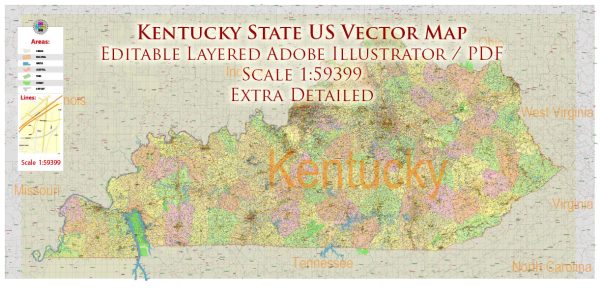Kentucky’s urban development has a rich history that reflects the state’s economic, social, and cultural evolution. While often associated with its rural character, Kentucky has experienced significant urban growth and transformation over the years. The following is a broad overview of Kentucky’s urban development history:
Early Settlements and Frontier Towns (Late 18th Century – Early 19th Century):
- Pioneer Settlements: The early European settlers in Kentucky established small communities primarily along the Ohio River and other waterways. Towns like Harrodsburg and Lexington were among the first to emerge as centers of trade and commerce.
- River Transportation: The importance of rivers, particularly the Ohio and Mississippi, played a crucial role in the development of towns. Louisville, located at the Falls of the Ohio, became a key river port and a hub for trade and transportation.
Antebellum Era (Early 19th Century – Civil War):
- Economic Expansion: The development of the hemp and tobacco industries contributed to the growth of urban areas. Cities like Louisville and Lexington expanded as economic and transportation hubs, fostering commerce and industry.
- Steamboat Era: The rise of steamboat transportation further enhanced the connectivity of Kentucky’s urban centers, facilitating the movement of goods and people.
Post-Civil War Industrialization (Late 19th Century):
- Railroads: The expansion of the railroad network in the late 19th century connected Kentucky’s cities more closely and facilitated the transportation of goods and people. Louisville, in particular, benefited as a rail and manufacturing center.
- Industrial Growth: Urbanization increased as industries such as tobacco processing and manufacturing expanded. Cities like Louisville, Covington, and Newport saw industrial development.
20th Century:
- Urbanization and Migration: The early 20th century witnessed a significant influx of rural residents into urban areas. Louisville and other cities became centers of population growth, with increased industrialization and job opportunities.
- Post-World War II Suburbanization: Like many other states, Kentucky experienced suburbanization in the mid-20th century, as people moved to the outskirts of cities. This trend reshaped the urban landscape, with the development of suburbs and the decline of some inner-city areas.
Recent Developments (Late 20th Century – 21st Century):
- Economic Diversification: Kentucky’s urban areas have diversified their economies beyond traditional industries. Louisville, for example, has seen growth in healthcare, technology, and logistics sectors.
- Revitalization Efforts: Some cities, including Louisville and Lexington, have invested in urban revitalization projects to enhance the quality of life, attract businesses, and preserve historic areas.
- Cultural and Educational Hubs: Urban centers like Lexington and Louisville have become cultural and educational hubs, with museums, universities, and vibrant arts scenes contributing to their appeal.
Kentucky’s urban development history is marked by a dynamic interplay of economic factors, transportation advancements, and social changes, reflecting the broader trends seen in the United States over the centuries.


 Author: Kirill Shrayber, Ph.D.
Author: Kirill Shrayber, Ph.D.